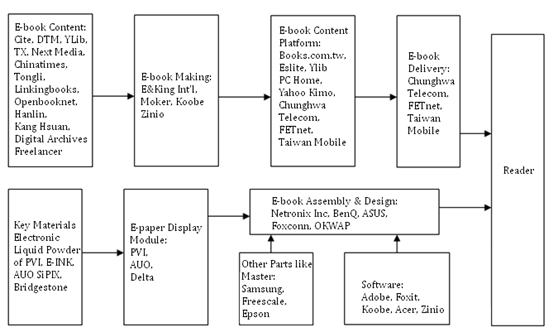|
Undoubtedly, e-book has been one of the much-talked-about topics in consumer electrics. Strictly speaking, only the readers with e-paper can be called e-book reader.
Taiwan E-book Industry Chain

E-book industry can be divided into five major components as follows, content provider, digital format producer, content distribution service platform, transmission platforms, and reader. Of the five, the reader, which belongs to hardware, is the most mature.
Sony has sold its own brand of e-book, and decided to launch products with the function of wireless download and touch panel. Google has also issued the e-book plan, and in China, besides Jinke Hanlin, the companies such as Hanwang, Founder, Ebiox, Avoex and Onyx also have launched such products.
However, the competition among the terminal products has just started. The success of Amazon also rests with its powerful content service, and the consumers can buy Amazon genuine e-book via free wireless access such as Sprint 3G mobile phone network. It will be a big challenge for China’s e-book market that has been used to free service.
In fact, to digitalize books is not as simple as it seems. The operation flow begins with the digitalization of book content, and then it should protect digital content via the technologies such as DRM system, encryption and attestation in order to avoid copyright embezzlement. After that, a smooth download & charging system should be required so that the consumers can download their favorite content in books or magazines to e-readers via such system and service platform.
PVI is the only e-paper manufacturer capable of mass production in terminal hardware field in Taiwan. Founded on Jun 2nd, 2009, PVI acquired E-INK at the price of USD200 million. With best whiteness and short response time, it is the most mature and excellent e-paper technology, closest to traditional books. Nearly all global e-book readers adopt PVI e-paper, and the 6-inch e-paper display module is priced at US$60. The order has been scheduled to the end of Jun, 2010, and rate of capacity utilization is up to 100%. In addition, AUO invested US$30 million to get 31.58% shares of SiPix Imaging in Mar, 2009 and became the largest shareholder, while the MicroCup technology originally corresponded to electric tag rather than e-paper. Then AUO changed into e-book reader at once, but the whiteness, resolution and response are not as good as PVI E-INK. AUO also reported that it had employed mass production in Sep, 2009.
The electronic liquid powder, produced by the world's largest tire manufacturer, Bridgestone, has also entrusted Taiwan companies for industrialization. Its partner, Delta Electronics is the global largest adapter manufacture, and the electronic paper in trial production was a bit yellow, and rather slow in response. However, in Sep, 2009, Bridgestone announced that the responsiveness had been greatly improved.
Taiwan manufacturers take the advantages of geographic locations and convenient traffic in the field of downstream assembly manufacturing. Netronix Inc, 13% shares of which are held by PVI, is the second largest e-book reader manufacturer followed by PVI, and its shares have increased several times. AUO has not achieved mass production now, the shares of which have doubled already. Besides, the companies such as ASUS, Foxconn and Inventec all have entered e-book reader sector.
The price of e-book reader is still higher comparatively, and the maturity of AUO SiPix technology is still to be tested. Considering the current supply and demand, what PVI can only do is to increase price. The display module is the most expensive part of e-book, followed by the most used Qualcomm 3G chip set and Freescale IMX31 processor. The price is the key factor to hinder the prevalence of e-book reader, then the content. However, the content provider is substantially excellent in American market.
For more details, please visit http://www.researchinchina.com/Htmls/Report/2009/5758.html |